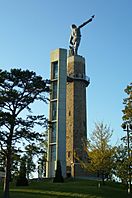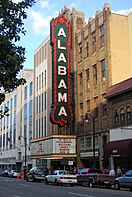Birmingham metropolitan area, Alabama facts for kids
Quick facts for kids
Greater Birmingham
|
|
|---|---|
| Birmingham, AL Metropolitan Statistical Area | |
|
Clockwise from top: Downtown Birmingham, Alabama Theatre in Downtown Birmingham, Old Mill in Mountain Brook, Aerial picture of Samford University in Homewood, Vulcan statue in Birmingham
|
|
| Country | |
| State | |
| Largest city | |
| Principal cities | - Hoover - Vestavia Hills - Alabaster - Homewood - Trussville - Bessemer - Talladega - Sylacauga - Cullman |
| Area | |
| • Total | 11,830 km2 (4,566 sq mi) |
| Population
(2020)
|
|
| • Total | 1,115,289 |
| • Rank | 50th |
| • Density | 84/km2 (217/sq mi) |
| Time zone | UTC−5 (CST) |
| • Summer (DST) | UTC−4 (CDT) |
| Area codes | 205, 659 |
The Birmingham metropolitan area, also called Greater Birmingham, is a large region in north central Alabama, United States. It includes the city of Birmingham and many towns around it.
As of 2023, the U.S. government says the Birmingham area includes seven counties. These are Bibb, Blount, Chilton, Jefferson, St. Clair, Shelby, and Walker. In 2020, about 1.18 million people lived here. This makes it the 50th largest metropolitan area in the U.S.
The Birmingham area is also part of an even bigger region. This larger area is called the Birmingham–Cullman–Talladega, AL Combined Statistical Area. It includes the seven counties mentioned above, plus Cullman County, Talladega County, and Coosa County.
In 2020, this larger combined area had about 1.4 million people. It is the biggest population region in Alabama. This means about one-fourth of Alabama's people live here. It is also the largest population area in central Alabama.
Contents
Counties in Greater Birmingham
Greater Birmingham includes several counties. Some are part of the main metropolitan area. Others are part of the larger combined statistical area.
Counties marked with * are part of the bigger Birmingham–Cullman–Talladega, AL Combined Statistical Area.
Cities in Greater Birmingham
| Historical population | |||
|---|---|---|---|
| Census | Pop. | %± | |
| 1900 | 140,420 | — | |
| 1910 | 226,476 | 61.3% | |
| 1920 | 310,054 | 36.9% | |
| 1930 | 431,493 | 39.2% | |
| 1940 | 459,930 | 6.6% | |
| 1950 | 556,926 | 21.1% | |
| 1960 | 812,094 | 45.8% | |
| 1970 | 833,075 | 2.6% | |
| 1980 | 930,281 | 11.7% | |
| 1990 | 956,844 | 2.9% | |
| 2000 | 1,052,238 | 10.0% | |
| 2010 | 1,061,024 | 0.8% | |
| 2020 | 1,115,289 | 5.1% | |
| 2021 (est.) | 1,114,262 | 5.0% | |
| U.S. Decennial Census | |||
Main City
- Birmingham is the largest city in the area.
Important Cities
These cities are also very important to the region.
Cities marked with * are part of the larger Birmingham–Cullman–Talladega, AL Combined Statistical Area.
Other Large Towns
Many other towns in Greater Birmingham have over 10,000 people.
- Alabaster
- Bessemer
- Calera
- Center Point
- Chelsea
- Clay
- Fairfield
- Forestdale
- Gardendale
- Helena
- Homewood
- Hoover
- Hueytown
- Irondale
- Jasper
- Leeds
- McCalla
- Moody
- Mountain Brook
- Pelham
- Pell City
- Trussville
- Vestavia Hills
People and Diversity
In 2019, over 1 million people lived in the Birmingham–Hoover area. The population is made up of different groups. About 65.8% were White, and 31.6% were African American. About 4.5% of the people were Hispanic.
What Drives the Economy
The economy of Greater Birmingham is very diverse. This means it has many different types of jobs and businesses. Many big companies are located in Birmingham and Jefferson County. The economy includes service jobs like banking and finance. It also has health research and heavy industry.
The University of Alabama at Birmingham (UAB) is the largest employer in Alabama. It has about 20,000 employees. Major companies like Regions Financial and Books-A-Million have their main offices here. Books-A-Million is the second largest book store chain in the U.S.
Top Employers
Many large companies provide jobs in Greater Birmingham.
- Alabama Power
- American Family Care
- Amazon
- AT&T
- Blue Cross and Blue Shield Association of Alabama
- Books-A-Million
- Drummond Company
- EBSCO Industries
- Encompass Health
- Hibbett Sports, Inc.
- Liberty National Life Insurance Co.
- McWane, Inc.
- Motion Industries
- PNC Financial Services
- Regions Financial Corporation
- Royal Cup Coffee, Inc.
- Shipt
- Sloss Industries
- Southern Research Institute
- Spire Inc
- Torchmark
- University of Alabama at Birmingham
- Vulcan Materials Company
- Wells Fargo
Shopping Fun
Birmingham is a popular place for shopping in Alabama. It has many large shopping centers and malls.
Big Malls & Shopping Centers
- Riverchase Galleria: This is a very large indoor mall in Hoover. It has many stores.
- The Summit: This is an outdoor shopping area with fancy stores. It is near Cahaba Heights.
- Pinnacle at Tutwiler Farm: This shopping center is in Trussville.
- The Shops At Grand River: This is an outlet mall in Leeds, where you can find good deals.
Getting Around
Roads and Highways
Greater Birmingham is a meeting point for four major interstate highways. These roads connect it to many other big cities.
- Interstate 65 goes north to Chicago and south to Mobile.
- Interstate 20 connects to Dallas and Atlanta.
- Interstate 59 links to New Orleans and Chattanooga.
- Interstate 22 connects to Memphis.
Interstate 459 is a highway that goes around the southern part of Birmingham. It helps people get around without going through the city center. Another highway, Interstate 422, is being planned. It will help traffic flow better in the northern part of the area.
Several U.S. highways also run through Greater Birmingham. These include US-31, US-11, US-78, and US-280. US-280 is known for having a lot of traffic. US-31 and US-280 join together in Homewood. They form the Red Mountain Expressway, which goes through a cut in Red Mountain. This road connects downtown Birmingham to its southern suburbs.
Main Highways
 Interstate 20
Interstate 20 Interstate 22
Interstate 22 Interstate 59
Interstate 59 Interstate 459
Interstate 459 Interstate 65
Interstate 65 U.S. Highway 11
U.S. Highway 11 U.S. Highway 31
U.S. Highway 31 U.S. Highway 67
U.S. Highway 67 U.S. Highway 231
U.S. Highway 231 U.S. Highway 280
U.S. Highway 280 U.S. Highway 411
U.S. Highway 411
Public Transportation
Birmingham has received money to improve its public transportation. A new station brings together Amtrak (trains), Greyhound (buses), and local buses.
Flying In and Out
The area is served by Birmingham-Shuttlesworth International Airport. Many airlines like American Airlines, Southwest, United, and Delta fly from here. They offer flights to over 40 cities. The airport was named after Rev. Fred Shuttlesworth, a civil rights leader.
Education and Learning
Colleges & Universities
Greater Birmingham has many colleges and universities.
- Bevill State Community College
- Jefferson State Community College
- Lawson State Community College
- Miles College
- Samford University
- University of Alabama at Birmingham
- University of Montevallo
Nature and Scenery
The area has many beautiful natural spots.
- Red Mountain
- Oak Mountain State Park
- Double Oak Mountain
- Ruffner Mountain
- Cahaba River National Wildlife Refuge
- Talladega National Forest (Oakmulgee Division)
Rivers in the Region
Several important rivers flow through Greater Birmingham.
- Cahaba River
- Black Warrior River
- Coosa River
- Locust Fork of the Black Warrior River
- Mulberry Fork of the Black Warrior River
- Sipsey Fork of the Black Warrior River
See also
 In Spanish: Área metropolitana de Birmingham–Hoover para niños
In Spanish: Área metropolitana de Birmingham–Hoover para niños






